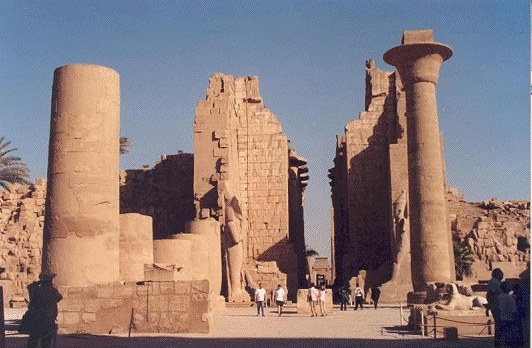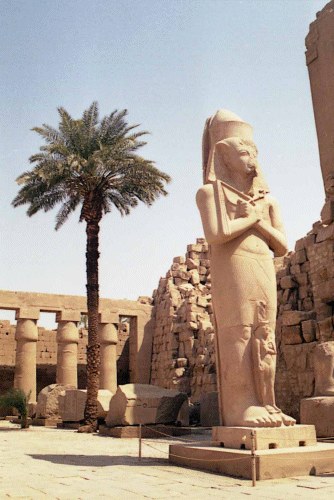We are now entering the first courtyard, known as the "Ethiopian Court" which dates to the 22nd Dynasty.
 To your right, you will see a great pillar with the open papyrus capital. This is one of the support structures for the wooden Pavilion of the Ethiopian King Taharqa, which he had built to shelter the sacred barques that were used to transport the gods during the Opet Festival. To your right, you will see a great pillar with the open papyrus capital. This is one of the support structures for the wooden Pavilion of the Ethiopian King Taharqa, which he had built to shelter the sacred barques that were used to transport the gods during the Opet Festival.
 Directly in front of you, is the Colossus of Pinudjem. It is believed that this statue was actually erected by the Great Ramses II and later usurped by the High Priest Pinudjem. The small figure of a woman standing on Pharaoh's feet is believed the be Nefetari, the Great Royal Wife, but could also be Benet-Anat, the daughter of Ramses by a second wife Isinofret. Directly in front of you, is the Colossus of Pinudjem. It is believed that this statue was actually erected by the Great Ramses II and later usurped by the High Priest Pinudjem. The small figure of a woman standing on Pharaoh's feet is believed the be Nefetari, the Great Royal Wife, but could also be Benet-Anat, the daughter of Ramses by a second wife Isinofret.
 In Egyptian art, the size of a figure has nothing to do with perspective or reality. It symbolizes the power and importance of the figure being represented. Therefore, kings and gods are always shown as being much larger than those around them. In Egyptian art, the size of a figure has nothing to do with perspective or reality. It symbolizes the power and importance of the figure being represented. Therefore, kings and gods are always shown as being much larger than those around them.



|

